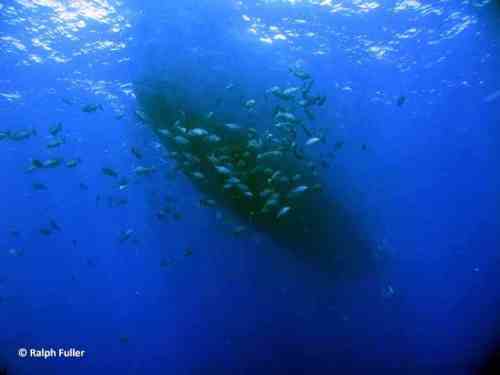Bermuda Chubs (Kyphosus sectatrix) are sort of the Charlie Browns of reef fish. Where many fishes, like Bluestriped Grunts and Gray Snapper spend their days hanging around waiting to go forth and scrounge in the sandflats once it gets dark, Bermuda Chubs just seem to hang around. None of my references make any mention of them being nocturnal foragers.

BERMUDA CHUBS ARE ELLIPTICAL-SHAPED, 10- TO 12-INCH FISHES reputed to earn their livings eating algae and small crustaceans and mollusks, but in my experience they spend their time hanging around high in the water column. In fact, their algae of choice appears to be brown algae, not generally found in the sandflats or grass patches.
And, oh yeah, they’ve been observed eating the feces and vomit of Spinner Dolphins.
THE THING IS…
I’ve seen Bermuda Chubs hanging around in small- to medium-sized schools underneath boats and above wrecks, but never pursuing any sort of food intake, reasonable or disgusting. But the second thing is that I confess that I’ve never paid much attention to them. See: “Charlie Browns,” above. They’re nice, just not charismatic. The third thing is, they do show up and hang around, so it’s useful to know who they are.
And, for that matter, the sources don’t seem to pay much attention to them, either. Some of my usual references don’t even mention them. Humann and DeLoach, perhaps the most detailed reference I’ve seen, say that they move in schools that swim rapidly over reefs and along walls. I haven’t seen that.
A TALE OF TWO CHUBS. ACTUALLY, MORE, JUST NOT OURS.

There are actually many other fishes in other families called chubs – both freshwater and marine – but Bermuda Chubs (that is, K. sectatrix) are the species most likely to be spotted on tropical reefs. Well, Humann and DeLoach note that there are actually two species of chubs seen on the reefs – the other is the Yellow Chub (K. incisor) – but they say the two are difficult to differentiate underwater. And, actually, other sources I have found seem to mix them up. Apparently, it’s not unusual for the two species to school together.
Bermuda Chubs are basically silver to dark gray in color. Adults typically display thin yellow stripes running the length of their bodies and, with K. sectatrix, white bands running from their mouths to their gill covers. With K. incisor, the Yellow Chub, the bands are likely to be yellow.

Juveniles sport thin white stripes rather than yellow, and feature white dots the size of their eyes along their head, bodies and fins. The young fishes are said to hang out near the surface among Sargassum seaweeds (No, I haven’t seen that, either).
WORLDWIDE, MANY NAMES

They all, adult and juvenile, are described as having “beaked” snouts. They’re found in tropical and subtropical oceans worldwide, all of which may account for other common names like Beaked Chub, Pacific Chub, Pacific Drummer, Gray Drummer and White Chub. Fish named “drummer” are usually guys that generate a drumming sound amplified by their swim bladders, but there’s no mention of that in any of the sources either.
PRINCIPAL SOURCES: Reef Fish Identification Florida, Caribbean, Bahamas, Paul Humann, Ned DeLoach; Kyphosus sectatrix, Fish Base; Bermuda Sea Chub Kyphosus sectatrix, Marine Species Identification Portal; Bermuda Chub (Kyphosus sectatrix), Identifyfish Blogspot; Kyphosus sectatrix, Wikipedia.
